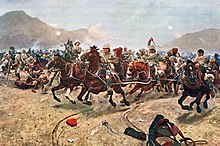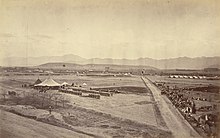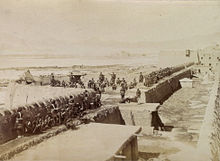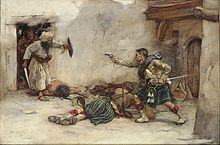Second Anglo-Afghan War
| Second Anglo–Afghan War | |||||||||
|---|---|---|---|---|---|---|---|---|---|
| Part of theGreat Game | |||||||||
 92nd Highlandersat Kandahar.Oil byRichard Caton Woodville Jr. | |||||||||
| |||||||||
| Belligerents | |||||||||
|
| |||||||||
| Commanders and leaders | |||||||||
|
| ||||||||
| Casualties and losses | |||||||||
|
Total fatalities are unknown
|
Total: 10,000 dead[7]
| ||||||||
| History ofAfghanistan |
|---|
 |
| Timeline |
TheSecond Anglo-Afghan War(Dari:جنگ دوم افغان و انگلیس,Pashto:د افغان-انګرېز دويمه جګړه) was a military conflict fought between theBritish Rajand theEmirate of Afghanistanfrom 1878 to 1880, when the latter was ruled bySher Ali Khanof theBarakzai dynasty,the son of formerEmirDost Mohammad Khan.The war was part of theGreat Gamebetween theBritishandRussianempires.
The war was split into two campaigns – the first began in November 1878 with theBritishinvasion of Afghanistan fromIndia.The British were quickly victorious and forced theAmir–Sher Ali Khanto flee. Ali's successorMohammad Yaqub Khanimmediately sued for peace and theTreaty of Gandamakwas then signed on 26 May 1879. The British sent an envoy and mission led by SirLouis Cavagnarito Kabul, but on 3 September this mission was massacred and the conflict was reignited byAyub Khanwhich led to theabdicationof his brother Yaqub.[8]
During this period,Abdur Rahman Khan,an opponent of the British, began distinguishing himself as a possible successor candidate to become the Amir of Afghanistan through his exploits in northern Afghanistan. Eventually after moving onKabul,he was crowned and then later recognized by the British as the ruler of Afghanistan.[9]
The second campaign began whenAyub Khan,the governor ofHerat,rebelled in July 1880 and marched on Kandahar, defeating the British at thebattle of Maiwand.The campaign ended in September 1880 when the Britishdecisively defeatedAyub Khan outsideKandahar.Abdur Rahman Khan, now the sole ruler, created the buffer the British wanted between theRajand the Russian Empire, British and Indian soldiers then withdrew from Afghanistan.[10]
Background
A significant political group in Afghanistan at the time were the Afzalids. The Afzalids were originally supporters ofMohammad Afzal Khanto the throne of Afghanistan during thecivil war on Dost Mohammad's succession.[11]The Afzalids were eventually defeated bySher Ali Khanbut many fled in exile toSamarkandin theRussian Empireunder the authority ofAbdur Rahman Khan,who was actively given asylum by the Russian government and brought worries to the British about a future pro-Russian claimant to the throne of Afghanistan.[12]
On one such occasion, theBukharansaided Muhammad Ishaq Khan, a son ofMohammad Azam Khan.He occupiedAqcha,but was later defeated.[13]Following his defeat, the Afghan governor ofBalkh,Muhammad Khan, purged much of the province of Afzalid supporters, seizing lands and exacting imprisonment and execution on those thought to be sympathizers. Districts that had aided the rebellion faced hefty fines, and the rulers of theChahar Wilayatwere mandatorily forced to re-affirm their allegiance to Sher Ali Khan by traveling to Kabul every year. In 1875, Husain Khan, the ruler ofMaimana,refused to honour his oath and executed several government officials, declaring allegiance under the ruler of Bukhara. The rebellion was quelled, however when the leaders of the insurrection were brought before Sher Ali, he refused to execute them in honour of their former oaths, and instead had Muhammad Khan killed. These circumstances of events brought further support to the Afzalids in Samarkand, with many Amirs of the Chahar Wilayat beginning to correspond with Abdur Rahman Khan and the Afzalid faction.[14]
After tension between Russia and Britain in Europe ended with the June 1878Congress of Berlin,Russia turned its attention to Central Asia. That same summer, Russia sent an uninvited diplomatic mission to Kabul.Sher Ali Khan,theAmir of Afghanistan,tried unsuccessfully to keep them out. Russian envoys arrived in Kabul on 22 July 1878, and on 14 August, the British demanded that Sher Ali accept a British mission too.[15]The British informed Sher Ali that a British mission would arrive in Kabul as well with or without his consent. However, as news of this arrived, Sher Ali's son and heir, Abdullah Jan had died. With mourning and the funeral taking place, nobody wished to show Sher Ali the British message. Eventually the message was revealed by his chamberlain. In a condolence message to Sher Ali, the British informed Sher Ali that the mission would leave Peshawar for Kabul in September.[16]
Lord Lytton,theviceroy of India,ordered a diplomatic mission to set out for Kabul in September 1878 but the mission was turned back as it approached the eastern entrance of theKhyber Pass.A deadline was established for 20 November, where if a response was not given by the Afghan government, war would be declared. A day before the deadline, Sher Ali sent a messenger to Peshawar but failed to arrive on time, and turned away after news of the British invasion began.[17][18]
War
First phase
The first campaign began in November 1878 when a British force of about 50,000 fighting men, mostly Indians, was distributed into three military columns which penetrated Afghanistan at three different points. The British victories at the battles ofAli MasjidandPeiwar Kotalmeant that the approach to Kabul was left virtually undefended by Afghan troops.[19]
An alarmedSher Alileft forMazar-i-Sharif.This was done in hopes of the British overstretching their armies in Afghanistan, and make it difficult for the British to occupy parts of southern Afghanistan for an indefinite period of time, as well as that the Afghan tribes would eventually rise up. Further drawing off ofDost Mohammad KhanandWazir Akbar Khan's tactics in theFirst Anglo-Afghan War.Mazar-i-Sharif was safe as well, with winter already ongoing, the British would be unable to pass the snow litteredHindu Kush.Alongside this, over 15,000 Afghan soldiers were present inAfghan Turkestan,which Sher Ali began preparing to assemble more men across Afghanistan. Sher Ali also attempted to appeal in person to the Russian Tsar for assistance, but he wasn't allowed to enter Russian territory, and their insistence was that he should seek terms of surrender from the British.[20]He returned toMazar-i-Sharif,where his health began to suffer, leading to his death on 21 February 1879.[21][22]
Before leaving for Afghan Turkestan, Sher Ali released the surviving governors of theChahar Wilayatthat he had previously imprisoned. Upon Sher Ali's arrival to Mazar-i-Sharif, Sher Ali promised them the return of their states if they had assisted against the British in the war to come. Many of the governors, having been imprisoned for longer then a decade, all due to similar oaths being broken. As a result, seeing an opportunity to declare independence, Muhammad Khan, the former governor ofSar-I-Pul,alongside Husain Khan, the former governor of theMaimana Khanate,all declared independence against Afghan rule, rallying their own armies and expelling Afghan garrisons. A wave of Turkmen raids also began into Afghan Turkestan as a result, seeing some 6,000 women being enslaved, with forces from Sher Ali to repel the raids being defeated.[22]
With Sher Ali's death, a tumultuous period began over his succession. One of his sons, Muhammad Ali Khan, attempted to seizeTakhtapul,however the garrison mutinied, forcing him to move south towardsDai Zangi,where he began assembling an army against Yaqub Khan.[23]
Yaqub Khanwas declared the new Amir, with many sardars that were thought to have ties with the Afzalid faction were imprisoned. In Mazar-i-Sharif, Yaqub Khan's son, Muhammad Musa, assembled a force and seized Takhtapul, sending the leader of the mutineers to Kabul, where he was executed. Ayub Khan, supporting his brother's succession, did not oppose him. However, much of the military forces and officers inBalkhandHeratinstead supported the Afzalids. Ayub Khan began facing anarchy in Herat, with much of the forces from the expelled from Maimana demanding payment. Ayub Khan sent numerous requests to Mazar-i-Sharif, imminently requesting aid in cash. Despite receiving funds, the troops began rioting, and were turned away by Ayub Khan towards Yaqub Khan, stating he would be capable of paying them.[24]
Treaty
With British forces occupyingKabul,Sher Ali's son and successor, Yaqub Khan, signed theTreaty of Gandamakon 26 May 1879. According to this agreement and in return for an annual subsidy and vague assurances of assistance in case of foreign aggression, Yaqub relinquished control of Afghan foreign affairs to Britain. British representatives were installed in Kabul and other locations, and their control was extended to theKhyberandMichnipasses, and Afghanistan ceded variousNorth-West Frontier ProvinceareasandQuettato Britain, including the strategic fort ofJamrud.Yaqub Khan also renounced all rights to interfering in the internal affairs of theAfriditribe. In return, Yaqub Khan only received an annual subsidy of 600,000 rupees, with the British pledging to withdraw all forces from Afghanistan excludingKandahar.[25][26]
However, on 3 September 1879 an uprising in Kabul led to the slaughter ofSir Louis Cavagnari,the British representative, along with his guards, and staff – provoking the next phase of the Second Afghan War.[27]
Second phase

Major General SirFrederick Robertsled theKabul Field Forceover the Shutargardan Pass into central Afghanistan, defeated theAfghan ArmyatCharasiabon 6 October 1879, and occupiedKabultwo days later.[28]GhaziMohammad Jan Khan Wardak,and a force of 10,000 Afghans, staged an uprising and attacked British forces near Kabul in theSiege of the Sherpur Cantonmentin December 1879. The rebellion collapsed after the failure of a direct attack on Roberts' force on 23 December. Yaqub Khan, suspected of complicity in the massacre of Cavagnari and his staff, was obliged to abdicate. The British considered a number of possible political settlements, including partitioning Afghanistan between multiple rulers or placing Yaqub's brotherAyub Khanon the throne, but also looked to install his cousinAbdur Rahman Khan(half nephew of the former Sher Ali) as Amir instead.[29][30]

Exploits of Abdur Rahman Khan
Abdur Rahman Khan meanwhile had been in exile in Turkestan. Upon the death of Sher Ali Khan he requested from the Russians to enter Afghanistan as a claimant of the throne. This request was denied. However, followingYaqub Khan's abdication, as well as the British occupation of Kabul, the Russians allowed Abdur Rahman Khan to re-enter Afghanistan. Abdur Rahman made way forBadakhshan,whose ruler he had marriage ties with. While on route, he did a pilgrimage to the shrine ofKhwaja Ahrar,taking his banner after claiming he had a vision that ensured victory. The ruler of Badakhshan did not permit Abdur Rahman to ford the Amu Darya, to which Abdur Rahman did so further downstream. He then crossed a mountain pass while it snowed, arriving atRostaq,where its garrison defected. With the fall of Rostaq, Abdur Rahman met the Mir of Badakhshan in battle, forcing him to flee toChitralwhile Abdur Rahman annexed Badakhshan.[31]
Abdur Rahman requested from Sultan Murad ofKunduzfor military access so he could advance onKabul.This request was denied. However, Ghulam Haidar Khan, Yaqub's governor ofBalkh,attacked Kunduz, occupying it, and forcing Sultan Murad to flee toFayzabad.Sultan Murad then alligned with Abdur Rahman, and encouraged rebellion against Ghulam Haidar, with the commander ofTakhtapuldeclaring for Abdur Rahman. Ghulam Haidar fled across the Amu Darya, leaving the entirety ofAfghan Turkestanunder Abdur Rahman's control.[32]
The British, eyeing for a suitable candidate to be the ruler ofAfghanistan,scouted Abdur Rahman Khan, and began negotiating with him. Abdur Rahman was reluctant to accept such a proposal, as he considered himself an opponent of the British, with his own men wishing for Jihad against them. While negotiations continued, the British considered numerous political solutions, including dividing Afghanistan into numerous kingdoms.[29][30]The British were seeking to a quick conclusion to the war due to the resignation ofLytton,with his successor, theMarquis of Ripon,wishing to withdraw all British troops from Afghanistan as quickly as possible. With this, the British no longer wished to uphold a British envoy in Afghanistan. However, both sides continued to differ, with the British wishing to keepKandaharunder their control with Sardar Sher Ali as governor, while Abdur Rahman saw it imperative as a part of Afghanistan.[9]
Believing that the British might withdraw, Abdur Rahman Khan arrived inCharikarsometime in July 1880, where religious leaders from regions such asPanjshir,Kohistan,andTagabwelcomed his arrival. On 19 July, the British informed Abdur Rahman that they were prepared to recognize him as the ruler of Afghanistan, inviting him to Kabul for a ceremony. Abdur Rahman called aJirga,with many tribal leaders declaring for him, while Abdur Rahman was declared the Amir ofKabul.[9]
Ayub Khan's rebellion
Ayub Khan, who had been serving as governor of Herat, rose in revolt, defeated a British detachment at theBattle of Maiwandin July 1880 and besieged Kandahar. Roberts then led the main British force from Kabul and decisively defeated Ayub Khan on 1 September at theBattle of Kandahar,bringing his rebellion to an end.[29]
Aftermath

With Ayub Khan defeated, the war was officially over with Abdur Rahman Khan ruling as Amir, he was seen as the real victor of the Second Anglo-Afghan War.[33]Despite attempts for the British to hold on toKandahar,they decided to return it back to Afghanistan. Rahman confirmed the Treaty of Gandamak, whereby the British took control of the territories ceded by Yaqub Khan. The provocative policy of maintaining a British resident in Kabul was abandoned, but instead British Indian Muslim agents were to be left to smooth liaison between the governments.[34]Britain would also handle Afghanistan'sforeign policyin exchange for protection and a subsidy.[15]TheAfghan tribesmaintained internal rule and local customs, and provided a continuing buffer between theBritish Rajand theRussian Empire.[10]Ironically many of these polices had been desired bySher Ali Khan,and war could have been prevented had they been implemented earlier.[33]
The war was expensive for Britain, spending some 17 million pounds during the war, which was three times the estimated cost. The costs rose just before the British left in March 1881, estimating to be around 19.5 million pounds.[35]
Despite attempts from the British to dissuade Afghanistan fromRussianinfluence, Abdur Rahman Khan adopted an autocratic government similar to the Tsars of Russia, inspired byPeter the Greatfrom his time in exile in Turkestan. Alongside this, despite the British attempting to prop up Afghanistan as a key ally, Abdur Rahman Khan often acted against the British, withatrocitieshorrifying evenQueen Victoria,and he became known as the 'Iron Amir'. He also refused to give information regarding his troops, with his own autobiography criticizing British policy, while also violating the Lyall agreement by instead of allowing the British to oversee his diplomatic affairs, held them himself with numerous countries includingIran,theOttoman Empire,and theGerman Empire.Abdur Rahman also wrote in pamphlets, encouraging Jihad against the British and the Russians, claiming both wished to end Afghanistan as a state. Senior British officials found it extremely difficult to further cooperate with Abdur Rahman Khan and Afghanistan due to the Turkestan atrocities, as well as hisactions against the Hazaras.The British believed they had no other alternative but to support Abdur Rahman Khan, scoring a diplomatic victory for him.[36]
Despite this, no further trouble resulted between Afghanistan and British India during Rahman's period of rule. The Russians kept well out of Afghan internal affairs, with the exception of thePanjdeh incidentthree years later, resolved by arbitration and negotiation after an initial British ultimatum.[37]
In 1893,Mortimer Durandwas dispatched to Kabul by British India to sign an agreement with Rahman for fi xing the limits of their respectivespheres of influenceas well as improving diplomatic relations and trade. On November 12, 1893, theDurand LineAgreement was reached. This led to the creation of a newNorth-West Frontier Province.
Timeline of battles
This sectionneeds additional citations forverification.(March 2024) |
There were several decisive actions in the Second Anglo–Afghan War, from 1878 to 1880. Here are the battles and actions in chronological order. An asterisk (*) indicates aclaspwas awarded for that particular battle with theAfghanistan Medal.



1878
- Battle of Ali Masjid* (British victory)
- Battle of Peiwar Kotal* (British victory)
1879
- Action at Takht-i-Pul (British victory)
- Action at Matun (British victory)
- Battle of Khushk-i-Nakud (British victory)
- Battle of Fatehabad (Afghan victory)
- Siege of the British Residency in Kabul(Afghan victory)
- Battle of Kam Dakka(British victory)
- Battle of Charasiab* (British victory)[38]
- Battle of Shajui
- Battle of Karez Mir
- Battle of Takht-i-Shah
- Battle of Asmai Heights* (Afghan victory)
- Siege of Sherpur(Kabul)* (British victory)
1880
- Battle of Ahmed Khel* (British victory)

- Battle of Arzu
- Second Battle of Charasiab(British victory)
- Battle of Maiwand(Afghan victory)
- Battle of Deh Koja (Afghan Victory)
- Battle of Kandahar* (British victory)
1881
- Evacuation of Kandahar (and Afghanistan) by British-led forces
Order of battle





In November 1878, at the start of the war, the British established threeField Forces– designatedPeshawar Valley,Kurram Valleyand Kandahar respectively – each of which invadedAfghanistanby a different route.[39]
- Peshawar Valley Field Force.[40]Lieutenant GeneralSir Samuel Browne
- Cavalry Brigade. Brigadier GeneralC. J. S. Gough
- 10th Hussars(2 squadrons)
- 11th Probyn's Lancers
- Guides Cavalry
- Royal Artillery
- First Infantry Brigade. Brigadier GeneralH. T. Macpherson
- 4th BattalionRifle Brigade
- 20th Brownlow's Punjabis
- 4th Gurkha Rifles
- Second Infantry Brigade. Brigadier General J. A. Tytler
- 1st Battalion, 17thLeicestershire Regiment
- Queen's Own Corps of Guides(infantry component)
- 51st Sikhs
- Third Infantry Brigade. Brigadier GeneralF. Appleyard
- Fourth Infantry Brigade. Brigadier General W. Browne
- Cavalry Brigade. Brigadier GeneralC. J. S. Gough
- Kurram Valley Field Force.[41]Major GeneralRoberts
- Cavalry Brigade. Brigadier GeneralHugh Gough
- 10th Hussars(1 squadron)
- 12th Cavalry
- 25th Cavalry
- Royal Artillery. Colonel A. H. Lindsay
- First Infantry Brigade. Brigadier General A. H. Cobbe
- 2nd Battalion,8th Foot
- 23rd Pioneers
- 29th Punjabis
- 58th Vaughan's Rifles
- Second Infantry Brigade. Brigadier General J. B. Thelwell
- Cavalry Brigade. Brigadier GeneralHugh Gough
- Kandahar Field Force.[42]Lieutenant GeneralDonald Stewart
- First Division
- Cavalry Brigade. Brigadier GeneralWalter Fane
- Royal Artillery. Brigadier GeneralC. G. Arbuthnot
- First Infantry Brigade. Brigadier General R. Barter
- 2nd BattalionKing's Royal Rifles
- 15th Sikhs
- 25th Punjabis
- Second Infantry Brigade. Brigadier General W. Hughes
- 2nd Division. Major GeneralM A Biddulph
- Cavalry Brigade. Brigadier General C. H. Palliser
- Artillery Colonel Le Mesurier
- First Infantry Brigade. Brigadier General R. Lacy
- Second Infantry Brigade. Brigadier General Nuttall
- First Division
At the end of the first phase of the war in May 1879, the Peshawar Force was withdrawn, while the Kandahar Force was reduced in size. In September 1879, at the beginning of the second phase, additional British andIndian Armyunits were despatched to Afghanistan, while the Kurram Valley Force was reinforced, and redesignated the Kabul Field Force.[43]
See also
- First Anglo-Afghan War
- Third Anglo-Afghan War
- Invasions of Afghanistan
- Waziristan campaign (1919–1920)
- Waziristan campaign (1921–1924)
- Waziristan campaign (1936–1939)
- Pink's War
- Waziristan rebellion (1948-1954)
- Military history of Afghanistan
- European influence in Afghanistan
- Sherpur Cantonment
References
- ^Schmidt, Karl J. (1995).An Atlas and Survey of South Asian History.M.E. Sharpe. p.74.ISBN978-1563243332.
British forces were victorious and Sher Ali was deposed
- ^Lee 2019,p. 382-383.
- ^Lee, Jonathan (2019).Afghanistan: A History from 1260 to the Present.Reaktion Books. p. 383.ISBN9781789140101.
- ^Lee 2019,p. 378.
- ^Blood 1996,pp. 20–21.
- ^abRobson, Brian. (2007).The Road to Kabul: The Second Afghan War 1878–1881.Stroud: Spellmount. p. 299.ISBN978-1-86227-416-7.
- ^Robson 2007,p. 297.
- ^Chisholm, Hugh,ed. (1911)..Encyclopædia Britannica.Vol. 28 (11th ed.). Cambridge University Press. p. 898.
- ^abcLee 2019,p. 378-379.
- ^abBarfield 2010,p. 145.
- ^Lee 2019,p. 326.
- ^Lee 2019,p. 332.
- ^Lee 2019,p. 334.
- ^Lee 2019,p. 339-340.
- ^abBarthorp 2002,pp. 85–90.
- ^Lee 2019,p. 356-357.
- ^Barthorp 2002,pp. 66–67.
- ^Lee 2019,p. 357-358.
- ^Afghanistan 1878-1880 The Build-Up to Conflictat britishempire.co.uk
- ^Sinhai, Damodar Prasad. "India and Afghanistan, 1876", p. 183.
- ^Hanna 1904,pp. 150–155.
- ^abLee 2019,p. 359-360.
- ^Lee 2019,p. 364.
- ^Lee 2019,p. 360-364.
- ^Lee 2019,p. 365-366.
- ^Barthorp 2002,p. 71.
- ^Wilkinson-Latham 1977,p. 15.
- ^Barthorp 2002,pp. 77–79.
- ^abcWilkinson-Latham 1977,pp. 16–17.
- ^abBarthorp 2002,pp. 81–85.
- ^Lee 2019,p. 376.
- ^Lee 2019,p. 377.
- ^abLee 2019,p. 381-383.
- ^Prasad, Bisheshwar (1979).Foundations of India's Foreign Policy: Imperial Era, 1882-1914.Nayad Prokash. p. 25.
- ^Robson 2007,p. 277.
- ^Lee 2019,p. 384-397.
- ^Conflict in Afghanistan: A Historical EncyclopediaBy Clements, F. ABC-Clio, Santa Barbara, California, 2003 p. 198
- ^Alikuzai, Hamid Wahed (2013).A Concise History of Afghanistan in 25 Volumes, Volume 14.Trafford Publishing. p. 594.ISBN978-1490714417.
- ^Farwell 1973,p. 203.
- ^Joslin; Litherland; Simpkin (1988).British Battles and Medals.London:Spink & Son.p. 155.ISBN0-907605-25-7.
- ^Roberts 1897,p. 553,Appendix III.
- ^Luscombe, Stephen."Second Afghan War".britishempire.co.uk.Retrieved2022-11-07.
- ^Farwell 1973,p. 207.
Bibliography
This article incorporates text from a publication now in thepublic domain:Chisholm, Hugh,ed. (1911). "Abdur Rahman Khan".Encyclopædia Britannica.Vol. 1 (11th ed.). Cambridge University Press. pp. 37–38.
- Barthorp, Michael (2002).Afghan Wars and the North-West Frontier 1839–1947.London: Cassell.ISBN0-304-36294-8.
- Barfield, Thomas (2010).Afghanistan: A Cultural and Political History.Princeton University Press.ISBN978-0-691-14568-6.
- Blood, Peter R, ed. (1996).Pakistan: A Country Study.Diane Publishing.ISBN9780788136313.
- Gathorne Gathorne-Hardy, 1st Earl of Cranbrook(December 1878),The Afghan War: a speech delivered in the House of Lords by the Right Hon. Viscount Cranbrook (Secretary State of India) on Monday, December 9th, 1878(1st ed.), Westminster:National Union of Conservative and Constitutional Associations,WikidataQ19077572
{{citation}}:CS1 maint: numeric names: authors list (link) - Farwell, Byron (1973).Queen Victoria's Little Wars.London:Allen Lane.ISBN0713904577.
- Hanna, Henry Bathurst (1904).The Second Afghan War, 1878-79-80: Its Causes, Its Conduct and Its Consequences.Vol. 2. Archibald Constable & Co.
- Johnson, Robert (2011).The Afghan Way of War: How and Why They Fight.Oxford University Press.ISBN9780199912568.
- Roberts, Sir Frederick (1897).Forty-one Years in India.London: Macmillan & Co.
- Walker, Phillip Francis.Afghanistan: A Short Account of Afghanistan, Its History, and Our Dealings with It.London: Griffith and Farran (1881).
- Wilkinson-Latham, Robert (1977).North-West Frontier 1837–1947.London: Osprey Publishing.ISBN0-85045-275-9.
External links
- Second Anglo-Afghan War 1878–1880
- Second Anglo-Afghan War Chronology
- British Battles
- Online Afghan Calendar with Historical dates
- Frederick Roberts and the long road to Kandahar
- Anne S. K. Brown Military Collection, Brown University LibraryWilliam Simpson's diary and album of sketches and watercolours covering the early part of the campaign, and done for theIllustrated London News
- Afghanistan & the British Raj: The Second Afghan War & its AftermathFrom theRoyal Geographical Society of South Australiablog entries for Afghanistan & the British Raj that cover the subject chronologically with images through reference works in our collection.
- Second Anglo-Afghan War
- Anglo-Afghan Wars
- 1870s in Afghanistan
- 1880s in Afghanistan
- Emirate of Afghanistan
- Invasions of Afghanistan
- Invasions by the United Kingdom
- Modern history of Afghanistan
- Great Game
- Wars involving Afghanistan
- Wars involving the United Kingdom
- Battles involving British India
- Military history of Khyber Pakhtunkhwa
- 1878 in Afghanistan
- 1879 in Afghanistan
- 1880 in Afghanistan
- 1870s in British India
- 1880s in British India
- Battle honours of the King's Royal Rifle Corps
- 19th-century military history of the United Kingdom
